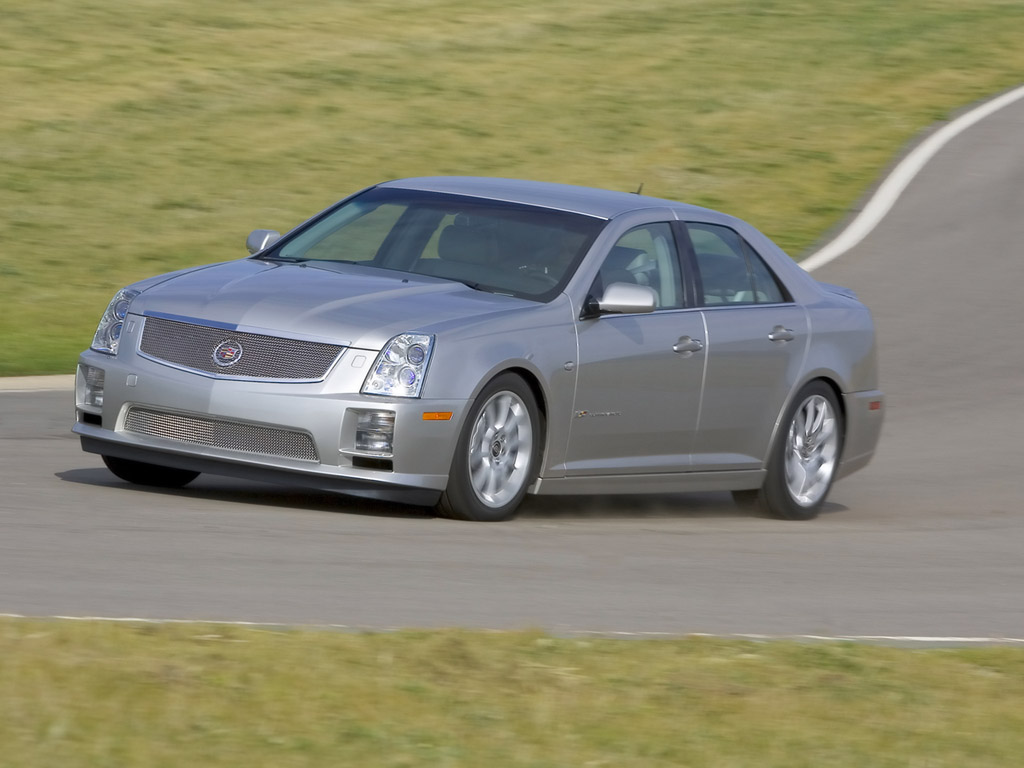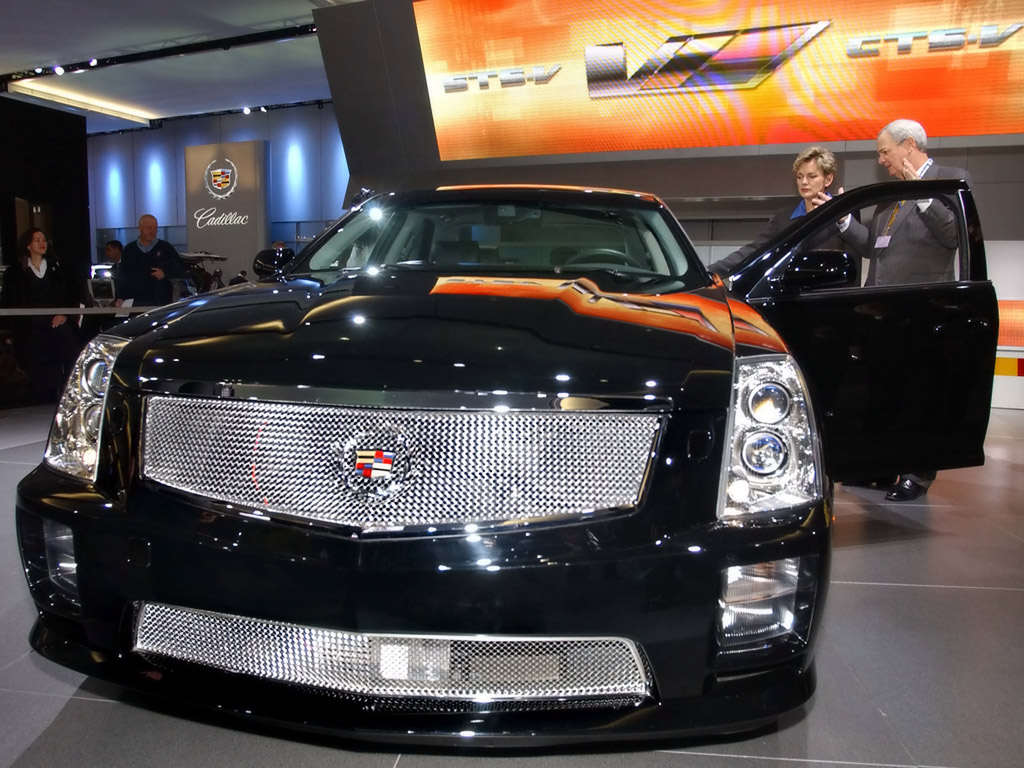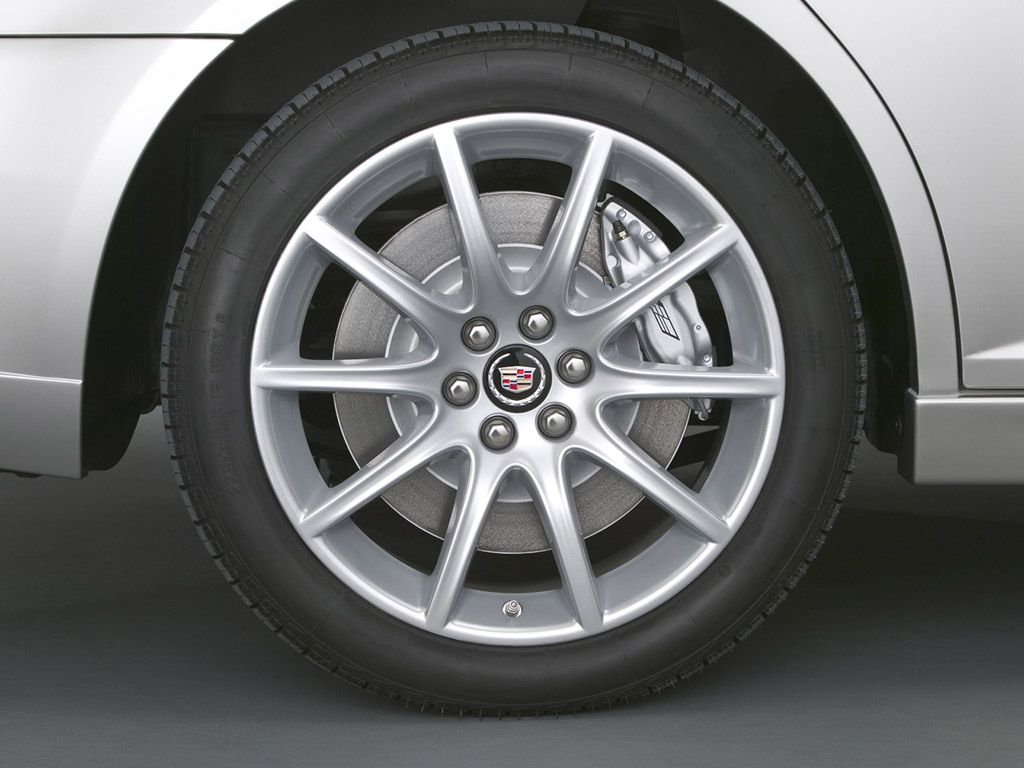2006 Cadillac STS-V
|
Price |
-- |
Production |
-- | ||
|
Engine |
4.4 liter DOHC V8 |
Weight |
4294 lbs | ||
|
Aspiration |
intercooled supercharger |
Torque |
430 lb-ft @ 3600 rpm | ||
|
HP |
440 @ 6400 rpm |
HP/Weight |
9.8 lbs per hp | ||
|
HP/Liter |
100 hp per liter |
1/4 mile |
-- | ||
|
0-62 mph |
-- |
Top Speed |
-- |
(from GM Press
Release) The 2006 Cadillac STS-V is General Motors’ most
intense expression of Cadillac power and performance yet, and the
luxury nameplate’s latest offering in its growing family of
high-performance V-Series vehicles.
The STS-V carries all the craftsmanship and sophistication of its
STS sibling, but does so at an entirely different level. Designed
for everyday driving, the STS-V has been developed to deliver
supercharged, rear-drive performance with an elegant design
statement that is unmistakably Cadillac.
At the heart of the STS-V is a new, 4.4-liter version of the
Northstar engine outfitted with a positive displacement intercooled
supercharger. The dual overhead cam (DOHC) V-8 engine delivers the
highest horsepower rating of any production Cadillac engine to date.
Called the Northstar V-8 SC (supercharged), the engine produces 440
horsepower (328 kW) at 6400 rpm and 430 lb.-ft. (583 Nm) of torque
at 3600 rpm (power and torque figures estimated) – and the engine’s
power is underscored by its ability to deliver 90 percent of its
peak torque between 2200 and 6000 rpm. Vehicle redline is 6700 rpm.
The Northstar V-8 SC generates 120 horsepower (90kW) and 115 lb.-ft.
(156 Nm) of torque more than its naturally aspirated counterpart,
while its specific output of 100-horsepower-per-liter makes it one
of the world’s highest specific output production V-8 engines.
However, the Northstar V-8 SC used in the STS-V is more than just
power and torque. The DOHC engine includes variable valve timing
that enables outstanding top-end performance while maintaining the
expected refinement and quality associated with a luxury marque.
The aggressive torque curve enabled by the choice of a supercharged
engine gives the STS-V acceleration capable of placing it firmly in
the under-5-second-club for 0-to-60 time. The refined shift feel is
enabled by careful electronic calibration of both the engine and
transmission. During shifts, power is instantaneously lowered, then
ramped back up carefully to make gear changes virtually
unnoticeable.
The Northstar V-8 SC is mated to the all-new Hydra-Matic 6L80
six-speed automatic transmission – the first use of GM’s new
six-speed automatic. The 6L80 – the only transmission offered on the
STS-V – is one of the most technologically advanced automatic
transmissions in the industry, using clutch-to-clutch operation and
an advanced integrated 32-bit transmission controller to deliver
smooth and precise shifts.
The 6L80 also incorporates a host of advanced driving enhancement
features, including advanced Performance Algorithm Shifting (PAS)
and Driver Shift Control (DSC). PAS lets the electronic transmission
controller override the automatic gear selection during closed
throttle high lateral acceleration maneuvers, rapidly downshifting
with the release of the torque converter clutch for smooth powering
up when the throttle is reopened. Driver Shift Control allows the
driver to sequentially shift gears manually via the gearshift lever.
The STS-V has been tuned for performance on virtually every road
condition and environment including GM’s all-new Milford Road Course
facility and the Nordschleiffe (North Course) at Nürburgring.
As a result of this extensive development, the vehicle has
track-capable acceleration, braking and cornering abilities. This is
due, in part, to increased tire sizes (P255/45R18 front, P275/40R19
rear); increased brake rotor diameters, larger pad areas, and larger
calipers; increased stiffness stabilizer bars and suspension
springs; a faster steering ratio; and chassis tuning aimed at
delivering high performance without punishing the driver.
Exterior elements on the STS-V enable higher-performance
capabilities; yet express the sophisticated elegance associated with
the STS name. Exterior refinements include:
A larger, polished stainless steel wire mesh front grille that enables the required additional airflow for engine heat dissipation. The wire mesh grille not only signifies the sedan as a V-series, but is also a heritage cue – wire mesh grilles were applied on the Cadillac V-16, the standard bearer of luxury and performance in the 1930s;
A new, lower front fascia that incorporates a larger lower grille (also wire mesh) for increased cooling capability; brake ducts for front caliper and rotor cooling; and splitter to counteract lift created by larger grille openings;
A new lower rear
fascia that facilitates smooth airflow under the vehicle for
improved cooling;
Lower rockers that visually bridge the lowered front and rear
fascias;
A specific, fluidly
sculpted hood designed to provide space for the engine’s
supercharger;
Ten-spoke, flangeless, painted aluminum alloy wheels that assist
in brake cooling. Front wheels are 18 x 8.5 inches; rear wheels
are 19 x 9.5 inches;
A higher, more rearward-positioned rear spoiler that enables balanced aerodynamic downforce with the front splitter; and
V- series badging prominently displayed on the vehicle’s rear decklid and front doors along with “Supercharged” block lettering on the doors.
The interior of the STS-V reflects craftsmanship with the addition of more leather-wrapped surfaces to promote a high-quality, tactile feel and distinctive, crafted appearance. Interior refinements include:
Hand-wrapped leather surfaces throughout;
Olive Ash Burl wood appointments;
Kinetic-finished aluminum accents;
Sueded fabric seat inserts;
V -series badging in the instrument cluster, on the instrument panel, and on door sill plates;
A new Tango Red color accent offering that is applied on seat inserts (front and rear), console, center armrest, lower instrument panel and door mid-sections (front and rear).
With three million
subscribers, OnStar is the nation's leading provider of in-vehicle
safety, security and information services using the Global
Positioning System (GPS) satellite network and wireless
technologies. The 2006 STS-V will offer OnStar’s Gen 6.1 system.
With Gen 6.1, GM OnStar subscribers can interact with OnStar's voice
recognition system in Spanish, French or English. With the push of a
button an OnStar advisor can change the system to allow the
subscriber to interact with the system in their preferred language.
Other core OnStar services are stolen vehicle location assistance,
remote door unlock, roadside assistance, emergency services and
automatic crash notification.
GM is the only automotive manufacturer committed to offering a full
range of vehicles with safety protection before, during and after a
collision. All OnStar-equipped vehicles come with Automatic Crash
Notification. If air bags deploy, the system sends a signal to a
highly trained OnStar Emergency Advisor, who contacts the vehicle to
see if help is needed, and can contact an emergency responder to
send for help. In many cases the occupants are severely injured and
cannot speak for themselves. OnStar’s GPS unit allows Advisors to
tell emergency responders the vehicle’s location. OnStar responds to
at least one air bag deployment in the US or Canada every hour.
Additionally, the 2006 STS-V will offer the GM-exclusive Advanced
Automatic Crash Notification system. The AACN system detects
collisions, even rollovers, regardless of whether air bags deploy.
AACN also transmits other crash data, such as the direction of
impact force, the number of and which air bags deployed and the
maximum change of impact velocity, so that emergency responders are
more prepared with this critical information before they arrive at
the accident scene.
The STS-V was engineered and executed by GM’s Performance Division,
an in-house center designed to explore potential enthusiast-oriented
versions of production models. No engineering, design or assembly
functions were outsourced – the vehicle is truly an original
equipment offering.
Like its STS sibling, the STS-V will be built at GM’s
state-of-the-art Lansing Grand River (LRG) assembly center beginning
in 2005. In 2004, the LGR facility received JD Power’s highest award
for plant quality in North America .
The STS-V is expected to arrive in Cadillac showrooms in the fourth
quarter of 2005.



